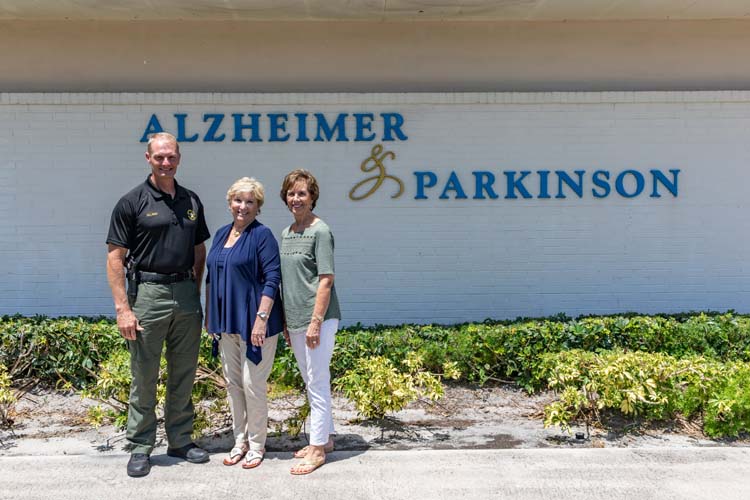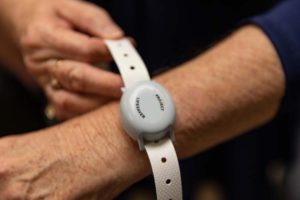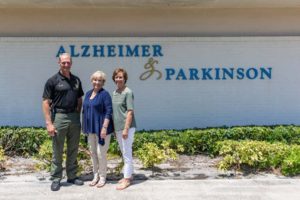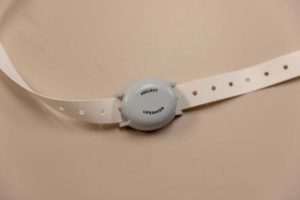
The clock begins ticking from the moment an individual suffering from Alzheimer’s or another form of dementia or brain trauma, or a child with autism wanders off. Individuals with cognitive brain disorders are not only more at risk of wandering; they often live in their own internal worlds, sometimes unaware of their immediate surroundings.

Project Lifeline bracelet
Although our local law enforcement agencies have an excellent track record of quickly locating people who wander off, two recent incidents have brought the issue to the forefront. In one, disaster was barely averted when a woman with Alzheimer’s was rescued just as she slipped beneath the water. Sadly, in the other incident, the woman has still not been found.
In both cases, Project Lifesaver devices – watch-sized, radio-frequency transmitter bracelets – could likely have assisted Indian River County Sheriff’s Office deputies in their search.
“Statistically there are 6,000 residents with dementia in this county and 60 percent of those will have a wandering event,” says Peggy Cunningham, executive director of the Alzheimer & Parkinson Association of Indian River County.
Sheriff’s Office statistics show missing person incidents appear to be on the rise: 119 in 2016, 149 in 2017, and 96 in 2018 as of August. “Families need to be aware of the statistics; how prevalent the wandering can be,” she adds. “One event can be the last.”
Despite those numbers, the majority of residents seem unaware that this free, but ultimately priceless resource is available to them through a partnership between the local Alzheimer & Parkinson Association, the Sheriff’s Office and the Treasure Coast Pilot Club.
“The eligibility is that they are a resident of Indian River County, they are at risk of wandering and they have full-time care,” says Cunningham. “Each month they come in, we take it apart, clean it out, we put in a new battery and we check to see if the signal is strong and on the correct frequency.”
They currently have just 50 active clients. “We know that there are hundreds out there who could use this, but it takes a long time for families to accept that dementia is going to be progressive.”
The launch of their Dementia Friendly Community Initiative and the purchase of a ‘Rolling Classroom’ RV, thanks to a 2017 Impact 100 grant, are helping to increase awareness.
“We feel that as people become more aware of it, we will have more clients on it. It’s such a good tool for caregivers,” says Cunningham. “Frequently the reason a family will come to us is that there has been a wandering event and the Sheriff’s Office has directed them here.”
Individual files with photos and other pertinent information are compiled by Alzheimer and Parkinson staff and shared with the Sheriff’s Office. The information can also be made available elsewhere if families travel out of town.
When someone goes missing, caregivers should immediately call 911 and, if applicable, identify them as a Project Lifesaver client. Handheld receivers are then deployed by IRCSO to helicopters and squad cars and are tuned into the bracelet’s radio frequency; each is unique.
“They have an internal speaker that will alert us that we’re getting closer to that individual or, if the signal’s faint, that we’re moving away from it. And then we can communicate that information to helicopters and ground units to try to triangulate where that person has gone,” says Lt. Lonnie Rich, IRCSO SWAT Commander.

Lt. Lonnie Rich, Peggy Cunningham, and Ester Rymer. Photo: Denise Ritchie
“A lot of it will depend on when we’re notified from the time that they left. A lot of families feel like they’re bothering us, thinking they may find their individual within five or 10 minutes and they want to wait and look for them themselves before notifying us. Keep in mind that it’s a lot easier to cancel us; that’s no problem,” he adds.
He stressed that ramping up resources after a delay of a couple of hours makes the search more difficult, especially if the person has access to a vehicle.
“So I would encourage anybody with a family member that leaves, whether or not they’re a participant in this program, to call us as soon as they realize they’re missing,” says Rich. “That will increase the success rate.”
Rich was extensively involved in the search for Susy Tomassi, a woman with dementia who remains missing after wandering from the Quilted Giraffe March 16. The IRCSO, notified roughly one hour after she was discovered missing, canvassed multiple routes from the restaurant to her home, conducted grid searches on foot in the Oslo Riverfront Conservation Area, and mobilized helicopters and ATVs to widen the search radius.
Cunningham says people with dementia are often physically fit, “and that’s the problem. Once they walk out the door, they’re trying to get some place but they’re not quite sure where it is, so they keep going and going. They feel like they’re making progress to do something; to go home. They’re completely disoriented, but it makes sense inside their world.”
The program is also an important tool for autistic children, says Cunningham, citing their use in some as young as 3 years old. “With autistic kids, families tell us that when they go, they move very fast.”
She says one little boy initially wanted nothing to do with it until his mother convinced him that the bracelet gave him superpowers. “By any means necessary,” Cunningham says with a laugh.
It is rare that the Sheriff’s Office does not locate missing persons, but it’s no less tragic for the families when they can’t.
“We’re pretty proficient in searching for missing people. We do it quite a bit at the Sheriff’s Office,” says Rich, explaining that they quickly speak with friends or family members, reach out to Go Line and car services, distribute a photo and clothing description, and issue BOLOs (be on the lookout) to neighboring counties and jurisdictions.
“All that’s happening within 10 or 15 minutes from the time we get the information, so that we can have our resources directed to where we think they might have gone,” he explains.
In addition to the Project Lifesaver search and rescue bracelets, there are now Protect and Locate devices, which trigger an individual home alarm (not an alarm to law enforcement) when someone wanders outside an electronic perimeter.

Project Lifeline bracelet
Project Lifesaver received its initial funding in 2005 through a $10,000 grant from the Treasure Coast Pilot’s Club, which continues to contribute about $2,000 per year through proceeds from their annual Pancake Day Breakfast (Jan. 26, 2019) and Autumn in the Park Arts & Crafts Fair (Oct. 6-7, 2018). Additional funding for devices and transmitters, and the $300 annual cost of replacement batteries and bracelet straps, comes from grants and other donations.
While clients are not charged for the equipment, Cunningham explains, “what we ask for is a $50 refundable down payment, but that can be waived. The purpose of that is to keep the caregiver aware that this equipment has to come back at some point, when they no longer need it. This is a $400 piece of equipment and it can be reused.”
To help get the word out, members of the TC Pilot Club recently volunteered to distribute 2,000 program brochures to local physicians’ offices. “We were hoping that that would get the information to people who really need it most,” says TCPC member, Ester Rymer. “It saves lives. We all hope that it never happens, but if it does and this can save their life, it’s all worth it.”
The Alzheimer & Parkinson Association of IRC was founded more than 35 years ago as an independent nonprofit and receives no funding support from other Florida or national organizations.
Their largest fundraiser is Walk to Remember, Nov. 3 at Riverside Park. For more information, visit alzpark.org.



